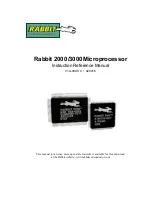
RUGGEDCOM ROX II
CLI User Guide
Chapter 10
Serial Server
Sink vs. Source Ports
339
Section 10.4.1.1
Sink vs. Source Ports
A serial port can act as either a
sink
and/or
source
port:
•
Sink Port
A sink port is a consumer of multicast packets. It registers itself to receive multicast traffic from a known
multicast group IPv4 address and destination UDP port and then forwards the traffic along the serial link. The
traffic is then received by a connected third-party serial device and processed.
•
Source Port
A source port is a producer of multicast packets. It receives serial traffic from a connected third-party serial
device and packetizes it into multicast IPv4 packets. Each packet is assigned a specific multicast group IPv4
address, destination UDP port and source UDP port.
Section 10.4.1.2
Multicast Streaming Examples
Serial multicast streaming can be deployed in multiple ways:
Serial Interfaces Configured as a Sink for Multicast Streams
In this configuration, the source of the multicast data comes from the Ethernet network interfaces and is
transmitted to multiple sink serial devices. The advantage of this scenario is the ease of configuration on the
Ethernet networking side. Instead of indicating which serial port to send to via unicast packets, the controller can
send a single multicast stream to all or some connected serial devices.
Serial Interfaces Configured as a Source for Multicast Streams
In this configuration, the source of the multicast data comes from the serial port and device side and is
transmitted to multiple Ethernet interfaces over one multicast stream. The advantage of this scenario is the ease
of configuration of listening devices. There will be a lesser need to keep track of IP addresses of interfaces, and
listeners can be easily substituted without concern over maintaining the same IP address.
Serial Interfaces Configured as a Source and Sink for Multicast Streams
In this configuration, the serial data is forwarded to other serial devices, with the ability to transmit to multiple
Ethernet interfaces via a single multicast stream. This is an extension of the two previous examples. The
advantage of this configuration is to allow one serial source device to send data to multiple receivers whether they
are another serial port or a listener device over an Ethernet network.
Section 10.4.2
Configuring Serial Multicast Streaming
To configure serial multicast streaming, do the following:
1. Add the rawsocket protocol. For more information, refer to
Section 10.2.3, “Adding a Serial Port Protocol”
2. Configure the Remote Host for the encapsulation of raw-socket serial over multicast with the destination
Multicast IP, UDP port, and interface(s). For more information, refer to
Section 10.5.2, “Adding a Remote
Section 10.7.2, “Adding a Remote Host Interface”
.
Содержание RUGGEDCOM ROX II
Страница 2: ...RUGGEDCOM ROX II CLI User Guide ii ...
Страница 4: ...RUGGEDCOM ROX II CLI User Guide iv ...
Страница 39: ...RUGGEDCOM ROX II CLI User Guide Table of Contents xxxix 19 5 VLANs 752 ...
Страница 40: ...Table of Contents RUGGEDCOM ROX II CLI User Guide xl ...
Страница 46: ...Preface RUGGEDCOM ROX II CLI User Guide xlvi Customer Support ...
Страница 96: ...Chapter 2 Using RUGGEDCOM ROX II RUGGEDCOM ROX II CLI User Guide 50 Accessing Maintenance Mode ...
Страница 170: ...Chapter 5 System Administration RUGGEDCOM ROX II CLI User Guide 124 Deleting a Scheduled Job ...
Страница 256: ...Chapter 6 Security RUGGEDCOM ROX II CLI User Guide 210 Enabling Disabling a Firewall ...
Страница 402: ...Chapter 11 Wireless RUGGEDCOM ROX II CLI User Guide 356 Managing Cellular Modem Profiles ...
Страница 646: ...Chapter 13 Unicast and Multicast Routing RUGGEDCOM ROX II CLI User Guide 600 Deleting a Multicast Group Prefix ...
Страница 732: ...Chapter 15 Network Discovery and Management RUGGEDCOM ROX II CLI User Guide 686 Viewing NETCONF Statistics ...
Страница 790: ...Chapter 17 Time Services RUGGEDCOM ROX II CLI User Guide 744 Deleting a Broadcast Multicast Address ...
















































